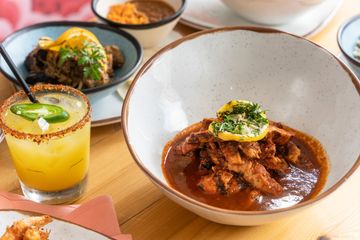Explore flavorful dishes served at best mexican westchester NY restaurants
What Are the Necessary Meals That Define Mexican Food?
Mexican food is a dynamic reflection of its social heritage, defined by a variety of essential recipes. Tacos, mole, pozole, tamales, and ceviche each tell a distinct tale of practice and flavor. These foods not just satisfy the palate yet also symbolize the spirit of neighborhood and celebration. Recognizing their significance reveals much regarding Mexico's cooking identification. What lies below the surface area of these cherished meals?

Tacos: The Quintessential Road Food
Tacos are commonly considered the essential road food of Mexico, commemorated for their flexibility and abundant tastes. They contain a simple tortilla, normally made from corn or flour, full of a variety of components that can vary from grilled meats to veggies. This adaptability permits many regional variations, each showcasing regional tastes and customs.
Popular fillings include carne asada, carnitas, and pollo, typically come with by fresh garnishes like cilantro, onions, and lime. Street suppliers expertly prepare and offer tacos, making them a hassle-free and budget friendly option for residents and vacationers alike.
The experience of consuming tacos is enhanced by the dynamic atmosphere of Mexican roads, where the aroma of seasonings and sizzling meat loads the air. This famous dish not just satisfies appetite however additionally stands for the social richness of Mexico, showing its history, community, and culinary artistry.
Mole: A Symphony of Flavors
Mole embodies the intricacy and deepness of Mexican food, supplying a rich tapestry of tastes that astound the palate. This sauce, frequently made with a mix of chilies, spices, nuts, and delicious chocolate, showcases the artistry and cultural heritage of Mexico. Each region boasts its distinct analysis, with variations such as mole poblano and mole , showing neighborhood ingredients and practices.
The prep work of mole is an elaborate procedure, needing skill and patience as the ingredients are carefully toasted, ground, and simmered to excellence. The resulting sauce can range from tasty to sweet, with layers of flavor that develop with each bite. Typically offered over poultry or turkey, mole transcends plain nutrition, typically enhancing special celebrations and celebrations. Its vibrant shade and complicated profile represent the abundant cooking identification of Mexico, making it a necessary dish that reverberates with both locals and visitors alike.
Pozole: A Hearty Tradition
Although usually taken pleasure in throughout cheery events, pozole is a recipe deeply rooted in Mexican practice, personifying both social significance and common spirit. This hearty soup, made mostly from hominy, meat-- usually pork or chicken-- and an abundant brew, has ancient origins that map back to pre-Columbian civilizations. Typically planned for celebrations such as Mexican Self-reliance Day and wedding celebrations, pozole transcends mere sustenance, cultivating a feeling of unity amongst those that participate.
The meal can be found in various local variants, including pozole blanco, verde, and rojo, each identified by its distinct active ingredients and flavor accounts. Toppings such as shredded cabbage, radishes, avocado, and lime enhance the recipe, enabling for individual expression. Past its delicious top qualities, pozole acts as a sign of heritage, linking generations via shared recipes and culinary methods. Its prep work typically ends up being a public occasion, enhancing bonds amongst family and good friends, making it a real symbol of Mexican friendliness.
Tamales: Wrapped in Love
Tamales hold a special location in Mexican cuisine, just like pozole, celebrating tradition and area. These delightful parcels of masa, or corn dough, are more usually full of a range of components, including meats, veggies, fruits, or cheeses, and after that wrapped in corn husks or banana leaves prior to being steamed to perfection - tacos. The preparation of tamales typically entails family celebrations, where generations collaborated to share the labor of blending, filling, and covering, enhancing their value as a communal recipe
Tamales are specifically preferred throughout cheery celebrations, such as Christmas and Día de los Muertos, symbolizing a link to cultural heritage. They are not just food; they symbolize love, care, and the giving of culinary abilities. Each region in Mexico flaunts its very own one-of-a-kind variations, showcasing neighborhood tastes and traditions, making tamales a cherished staple that transcends generations and joins individuals throughout the nation.
Ceviche: A Fresh Coastal Delight
Ceviche, a lively meal rooted in the seaside regions of Mexico, showcases the freshness of the ocean's bounty. Commonly made with raw fish marinaded in citrus juices, especially lime, ceviche is celebrated for its invigorating flavor account. The level of acidity from the lime "cooks" the fish, leading to a tender appearance that pairs perfectly with the his response bright components often included, such as diced tomatoes, onions, cilantro, and chili peppers.
Areas like Baja The Golden State and the Yucatán Peninsula have their own distinctive variations, including regional fish and shellfish such as shrimp, octopus, or scallops. Offered chilled, ceviche is frequently accompanied by tortilla chips or tostadas, improving its charm as a preferred appetiser or light meal. This recipe not just sushi places near me mirrors the rich aquatic life of Mexico but also highlights the social relevance of fresh, local components in Mexican gastronomy. Ceviche remains a cherished representation of seaside cooking practices.
Regularly Asked Inquiries
What Are the Trick Active Ingredients in Standard Mexican Cuisine?
Trick ingredients in standard Mexican cuisine include corn, beans, tomatoes, avocados, and chilies. lunch and dinner. These staples create the structure of lots of meals, showing the vibrant flavors and diverse cooking heritage of Mexico's abundant gastronomic landscape
Exactly How Has Mexican Cuisine Progressed With Time?
Mexican food has actually advanced via centuries, influenced by aboriginal customs, Spanish emigration, and worldwide ingredients. This dynamic mix has resulted in varied local tastes, techniques, and meals that remain to adjust and introduce with contemporary culinary patterns.

What Prevail Dietary Restrictions in Mexican Food Preparation?
Usual dietary limitations in Mexican food preparation include gluten, veganism, and vegetarianism intolerance. Lots of traditional meals can be adapted to suit these preferences, making sure that tastes remain lively while valuing specific dietary needs and social techniques.
Exactly How Do Regional Variations Impact Mexican Meals?
Regional variations substantially influence Mexican recipes with local ingredients, conventional food preparation approaches, and social influences. Each area's special climate and background contribute distinct tastes, methods, and recipes, leading to an abundant cooking variety across the nation.
What Beverages Set Ideal With Mexican Food?
Typical Mexican food sets well with drinks like horchata, aguas frescas, and tequila. Craft beers and mezcal likewise enhance the tastes, boosting the eating experience with their one-of-a-kind accounts and invigorating attributes.
Mexican cuisine is a lively representation of its social heritage, defined by a range of essential recipes. Mole symbolizes the complexity and depth of Mexican cuisine, offering a rich tapestry of tastes that captivate the taste buds. Usually delighted in throughout joyful events, pozole is a meal deeply rooted in Mexican tradition, embodying both social value and public spirit. Mexican food has developed through centuries, affected by aboriginal customs, Spanish emigration, and worldwide active ingredients. Regional variations significantly affect Mexican meals through local ingredients, typical food preparation techniques, and cultural influences.